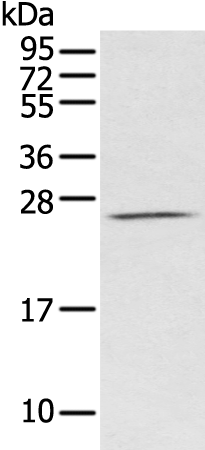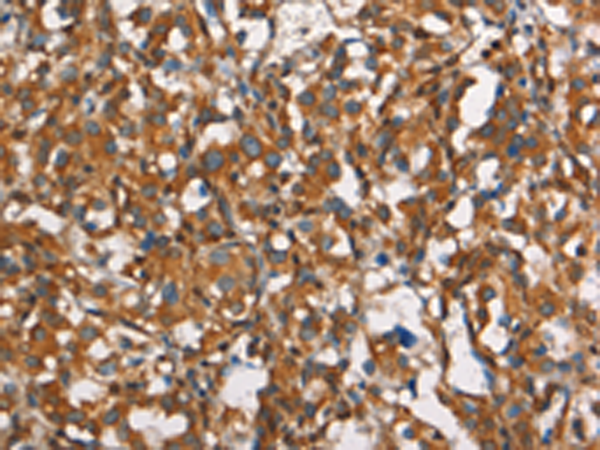


| WB | 咨询技术 | Human,Mouse,Rat |
| IF | 咨询技术 | Human,Mouse,Rat |
| IHC | 1/50-1/200 | Human,Mouse,Rat |
| ICC | 技术咨询 | Human,Mouse,Rat |
| FCM | 咨询技术 | Human,Mouse,Rat |
| Elisa | 1/5000-1/10000 | Human,Mouse,Rat |
| Aliases | CEA; CGM1; W264; W282; CD66D |
| WB Predicted band size | 27 kDa |
| Host/Isotype | Rabbit IgG |
| Antibody Type | Primary antibody |
| Storage | Store at 4°C short term. Aliquot and store at -20°C long term. Avoid freeze/thaw cycles. |
| Species Reactivity | Human, Mouse |
| Immunogen | Synthetic peptide of human CEACAM3 |
| Formulation | Purified antibody in PBS with 0.05% sodium azide and 50% glycerol. |
+ +
以下是关于CEACAM3抗体的3篇文献摘要信息:
---
1. **文献名称**:*CEACAM3: A Granulocyte Receptor Mediates Bacterial Opsonin-Independent Phagocytosis*
**作者**:Haucke, T., et al. (2004)
**摘要**:研究揭示CEACAM3通过其胞内ITAM结构域直接激活Syk激酶,介导中性粒细胞对病原体(如淋球菌)的抗体非依赖性吞噬作用。抗体阻断实验表明CEACAM3特异性抗体可抑制吞噬效率。
---
2. **文献名称**:*Antibody Cross-Linking of CEACAM1 and CEACAM3 Modulates Fcγ Receptor-Mediated Phagocytosis*
**作者**:Guldevall, K., et al. (2016)
**摘要**:通过抗体交联实验证明,CEACAM3与Fcγ受体协同增强巨噬细胞对IgG包被颗粒的吞噬作用,其机制可能与抗体诱导的受体聚集及下游信号通路激活有关。
---
3. **文献名称**:*Distinct Roles of CEACAM3 Cytoplasmic Domains in Antibody-Induced Phagocytosis*
**作者**:Muenzner, P., et al. (2010)
**摘要**:通过构建CEACAM3突变体并结合抗体阻断技术,发现其胞内ITAM结构域和脯氨酸富集区对抗体触发的吞噬及ROS产生至关重要,揭示了抗体结合后的信号传导路径。
---
如需更详细文献信息(期刊、卷号等),可进一步补充说明。
CEACAM3 (carcinoembryonic antigen-related cell adhesion molecule 3) is a glycoprotein belonging to the CEACAM family, which is part of the immunoglobulin superfamily. Primarily expressed in human granulocytes, particularly neutrophils, CEACAM3 plays a critical role in innate immunity by mediating rapid phagocytosis and elimination of bacterial pathogens. It functions as a pathogen recognition receptor, interacting with specific bacterial surface proteins (e.g., Opa proteins of *Neisseria* species) to trigger intracellular signaling pathways. Unlike other CEACAM family members involved in cell adhesion or immune modulation, CEACAM3 contains an immunoreceptor tyrosine-based activation motif (ITAM) in its cytoplasmic domain, enabling direct activation of antimicrobial responses without requiring additional co-stimulatory signals.
CEACAM3-specific antibodies are essential tools for studying its expression, localization, and function in immune responses. These antibodies are widely used in techniques like flow cytometry, immunofluorescence, and Western blotting to investigate neutrophil activation, pathogen-host interactions, and immune evasion mechanisms. Some studies also explore CEACAM3's potential as a therapeutic target, given its role in bacterial clearance. However, dysregulated CEACAM3 signaling has been implicated in inflammatory conditions, highlighting the need for precise antibody-based research to dissect its dual roles in protection and pathology. Commercially available CEACAM3 antibodies are typically validated for specificity against its extracellular or intracellular domains, aiding both basic research and translational studies in infectious diseases and immunology.
×